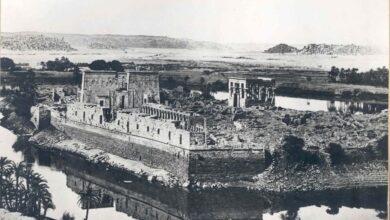A visit to… Philae Island Temples (Part 2)
By/Nasr Salama
In the first part, we continued with a detailed explanation of the name and history of Philae Island and the international rescue campaign that succeeded in dismantling and rebuilding the temples on the island of Agilika
In this “second” part, we continue to visit the most important landmarks of the island with its oldest archaeological buildings, which we head to after our arrival on the island at the southwestern end of the island, where the visit route starts from a cabin that is considered the oldest historically
: The cabin of King Naqtanbu
The cabin belongs to King Nectanebo I (380-362 BC), one of the kings of the Thirtieth Dynasty, and was dedicated to the goddess Hathor and Isis, and we will notice that the cabin was surrounded by 14 columns, of which only 4 columns remain, the reason for the destruction of the columns is because this southern part of the island was one of the first buildings affected by the flooding of the Nile when it came
We see the columns of Naktanbu’s cabin decorated with lotus-shaped crowns (one of the symbols of the south) and Hathorian heads topped by the so-called House of Horus and then the upper lintel, and connecting between the columns are wall curtains on which King Naktanbu’s relationship with the ancient Egyptian gods is recorded. We also note that the southern part of the cabin was decorated with two obelisks of which only part of the western obelisk remains, and the strange thing here is that obelisks often came at the front and not at the end of buildings, but perhaps for their small size they were erected at the end of the cabin
From Naqtanbu’s cabin, we can see the open courtyard and the entrance to the Temple of Isis, which obscures the temple halls behind it, and before completing the explanation, we have to stop here to give an idea about
: The myth of Isis and Osiris
The ancient Egyptians believed that the earth and sky were a male and female who married and had two sons, namely: Osiris and Set, and two daughters, Isis and Naftis. Osiris married his sister Isis and Set married his sister Naftis
Osiris took over the rule of the land, and he was good and generous in his dealings with people, which made him an example of goodness, and he taught people agriculture, planned villages and cities for them, and made laws for them, and people loved him, so his brother Set was envious of him, and he took revenge on his brother
Set prepared a cunning plan to kill his brother Osiris, where he held a big party to which he invited Osiris, then Set told his guests that he had prepared a surprise for them, a gift coffin of gold that would be the share of the one who came to match his size, and the guests took turns lying in the coffin until Osiris’ turn came (the size of the coffin was very suitable for Osiris. Set and his followers tightened the lid on the coffin with Osiris inside and threw him into the Nile River, which washed him into the Mediterranean Sea, whose waves carried him to Phoenicia and then tossed him to the coast of Thaghir Jubail
Isis was looking for her husband until the gods guided her to the city of Byblos, where she found the coffin and stayed there until she succeeded in escaping with her husband’s body and returned to Egypt. In Egypt, Isis went with the body to a hidden place in the swamps of the Delta and cried and prayed to the gods to restore life to her husband Osiris. As soon as he heard the sound, he rushed towards them and found his brother alive, so he revolted and tore up the body of Osiris and threw every part of it into the forty-two provinces of Egypt and threw it into the forty-two provinces of Egypt
Isis gave birth to her son Horus after she conceived him from the spirit of his father Osiris; she hid him in the bushes of the Delta until he grew up and was safe from the treachery of his uncle Set
When Horus grew up, he gathered supporters around him to avenge his father Set and claim his throne, and the country was divided into two camps for this, and the god wanted to triumph the right and good, so Horus won the throne of his father and became king of Egypt, and Osiris became a god of the dead
Thus, the story of Isis and Osiris shows that injustice does not last and that righteousness must triumph in the end.
The ancient Egyptians may have been inspired by the story of Cain and Abel and added to it from the imagination of the rest of the myth
: The open courtyard
There is no open courtyard similar to this courtyard in all Egyptian temples, and the difference here is the lack of symmetry in the number of eastern and western columns, as well as the incomplete capitals of some columns, which gives an idea of the method of carving the capitals of the columns
This courtyard was intended for pilgrims and visitors from the common people to watch the procession of Isis, and I believe that they stood behind the rows of eastern and western columns while the procession of the statue of Isis and the priests passed through the courtyard, and that these columns served as a barrier for them so that they would not approach the sacred procession
On the eastern side of the courtyard, there are about 17 columns, 6 of them complete with crowns, built by Ptolemy VIII, behind which there is a wall, and between the columns and the wall there is a roof that is still intact
If we look closely at the crowns of these columns, we will find that each crown differs from the previous one, so there are no two identical crowns despite their large number, and behind these columns is a wall on which various inscriptions are recorded of the relationship of the Roman emperors with the ancient Egyptian gods and some windows that were towards the island of Pegeh before the enforcement, where the tomb of Osiris is located
From the floor of the first courtyard and through your vision of the interior parts of the temple, you will find that the deeper you go inside the temple halls, the higher the level of the floor with the presence of some stairs that start from the first entrance, and this is explained by the fact that the closer you get to the Holy of Holies, the further you move away from the ground and rise to the sky, as you will notice that the first and second courtyards are exposed, then a hall half roofed followed by fully roofed halls, this darkness is intended to give awe and reverence as you advance towards the Holy of Holies, the place dedicated to the goddess Isis
See you in part three




